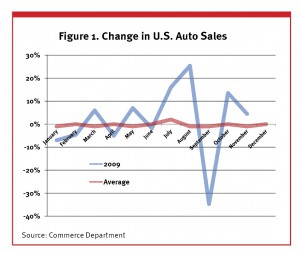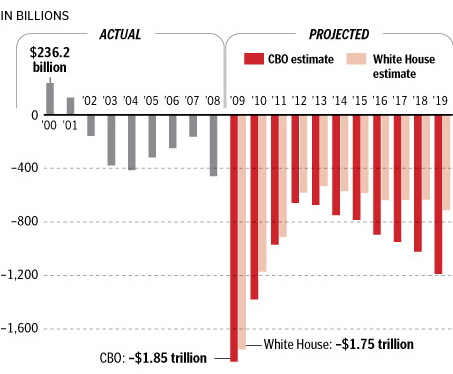I was wrong last night. I was attempting to argue a point about stimulus spending and whether or not government spending actually helped an economic recovery. To offer some support for my position, I tried to relay from memory a point that David Henderson made over at EconLog. To wit, Keynesian economists predicted that the end of government spending after World War 2 would precipitate a massive rise in unemployment and a return of recession.
David Henderson quoted Paul Samuelson's prediction, from before the war ended.
When this war comes to an end, more than one out of every two workers will depend directly or indirectly upon military orders. We shall have some 10 million service men to throw on the labor market. [DRH comment: he nailed that number.] We shall have to face a difficult reconversion period during which current goods cannot be produced and layoffs may be great. Nor will the technical necessity for reconversion necessarily generate much investment outlay in the critical period under discussion whatever its later potentialities. The final conclusion to be drawn from our experience at the end of the last war is inescapable--were the war to end suddenly within the next 6 months, were we again planning to wind up our war effort in the greatest haste, to demobilize our armed forces, to liquidate price controls, to shift from astronomical deficits to even the large deficits of the thirties--then there would be ushered in the greatest period of unemployment and industrial dislocation which any economy has ever faced. [italics in original]
Samuelson predicted that the government would act to avoid this catastrophe by slowly ramping down spending and acting to increase public employment.
For there is every reason to believe that we shall not be lulled into a feeling of false security by the last war's experience or by the half-truth that the end of the war will witness a boom. No doubt, we shall retain direct controls for a period after the conflict ends. We shall taper off war production gradually. We shall undertake income maintenance in the form of dismissal pay for soldiers, unemployment compensation, direct and work relief expenditure. It is probable, although less certain, that, in addition, the Federal government will initiate employment maintenance measures such as large scale public works, etc. But even these will not be adequate to maintain full employment or any approach to it.
Here's what Henderson said actually happened:
This reinforces the lesson from the far more extreme U.S. experience after World War II: Between FY 1945 and FY 1947, federal government spending was cut by 61 percent. This was a 27-percentage-point drop from 41.9 percent of GDP to 14.7 percent of GDP. Yet the unemployment rate over that same time rose from 1.9 percent to only 3.6 percent. The postwar bust that so many Keynesians expected to happen never did.
History shows that it's possible for government to sharply slash spending without sending the economy into a tailspin. So far, so good. This I remembered last night. Then I tried to remember what David Henderson said about the GI Bill. What I remembered reading was that comparatively few people took advantage of the GI Bill and that it didn't have a huge effect on the company. What Henderson actually said was that comparatively few people took advantage of it in any one year.
Of course, direct controls were removed relatively quickly, certainly within a year and a half of the end of the war. War production did not taper off gradually but plunged. I don't think there was any dismissal pay for soldiers. You could see the GI Bill as a form of relief expenditure, but if I recall correctly, at any given time only about 500,000 people were taking advantage of the GI Bill to get education. [italics mine]
Oops. As I learned last night, 7.8 million veterans eventually took advantage of the G.I. Bill.
Thanks to the GI Bill, millions who would have flooded the job market instead opted for education. In the peak year of 1947, veterans accounted for 49 percent of college admissions. By the time the original GI Bill ended on July 25, 1956, 7.8 million of 16 million World War II veterans had participated in an education or training program.
Now I'm intrigued by the qualification "education or training program". If we're going to count the G.I. Bill as stimulus, I think it makes a difference whether someone went to an actual 2-4 degree program or whether they just went to a training program and then entered the workforce.
Is David Henderson right? Were only about 500,000 people at a time taking advantage of the G.I. Bill? I don't know. I've been having a hard time tracking down the number of students enrolled in college during the 1940's. According to a 1947 Census report, 62.2% of the 6-24 year old population was enrolled in school. Of the 18-29 year old cohort actually enrolled in school, 75.1% of them were veterans. But I'm having a hard time tracking down the actual absolute number of people enrolled in school.
Answers.com has an estimate, but I'm not sure where it's sourced.
Initial expectations for the number of veterans who would utilize the educational benefits offered by the G.I. Bill were quite inaccurate. Projections of a total of several hundred thousand veterans were revised, as more than 1 million veterans were enrolled in higher education during each of 1946 and 1947, and well over 900,000 during 1948. Veterans represented between 40 and 50 percent of all higher education students during this period.
While the G.I. Bill also had an impact on home sales following the war, its unemployment provisions were little used.
Millions also took advantage of the GI Bill's home loan guaranty. From 1944 to 1952, VA backed nearly 2.4 million home loans for World War II veterans.
While veterans embraced the education and home loan benefits, few collected on one of the bill's most controversial provisions--the unemployment pay. Less than 20 percent of funds set aside for this were used.
Job training and higher education certainly took off after World War II, much of it aided by the jobs bill. But overall government stimulus was negative as government spending was cut sharply and as millions of service men and women returned to the civilian workforce. In contrast to Keynesian predictions, the economy responded with a surge of growth and not another slump into recession.

